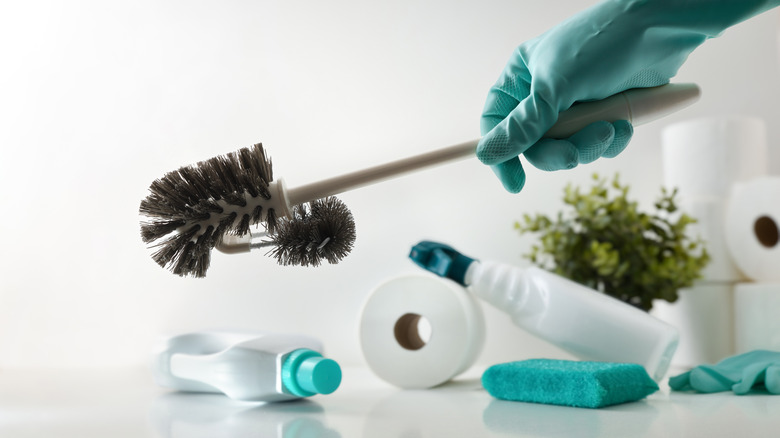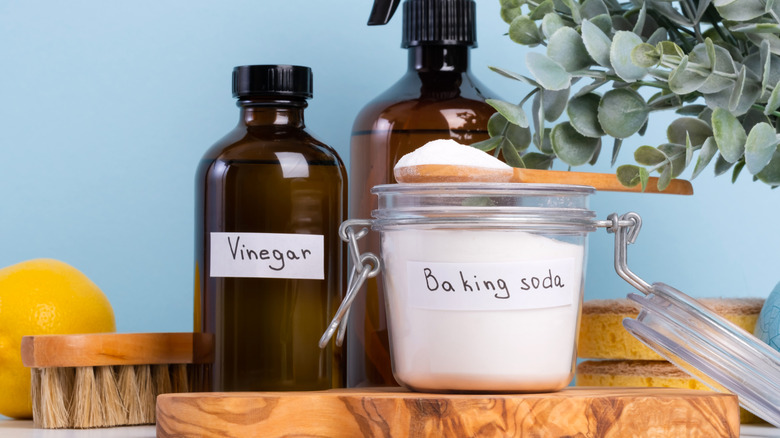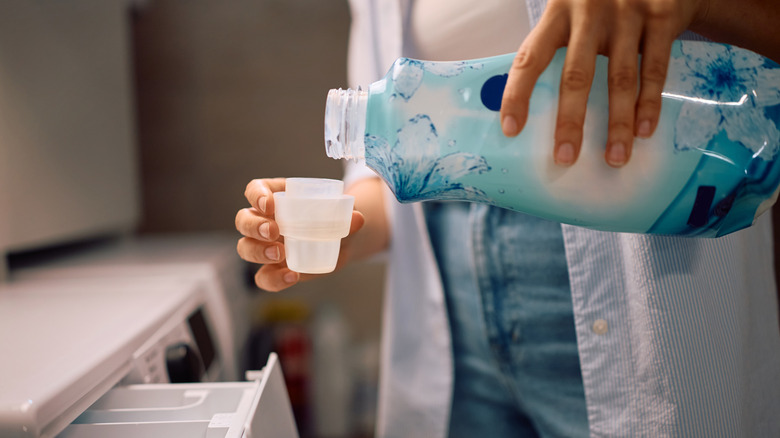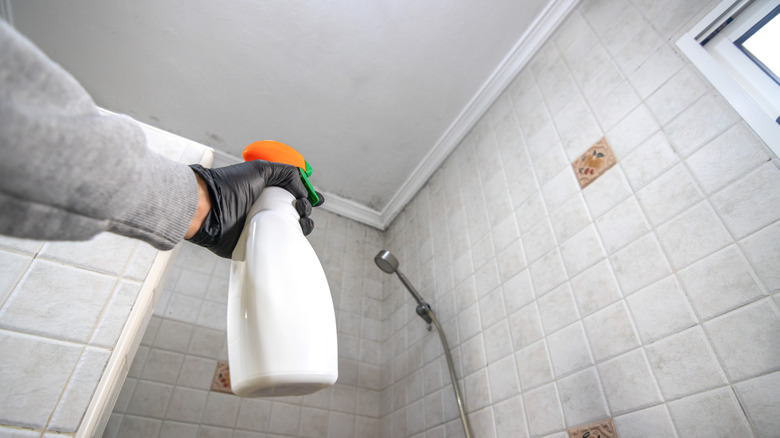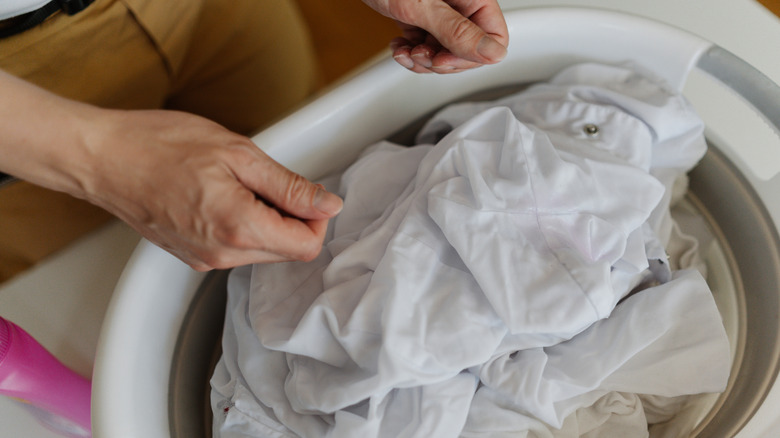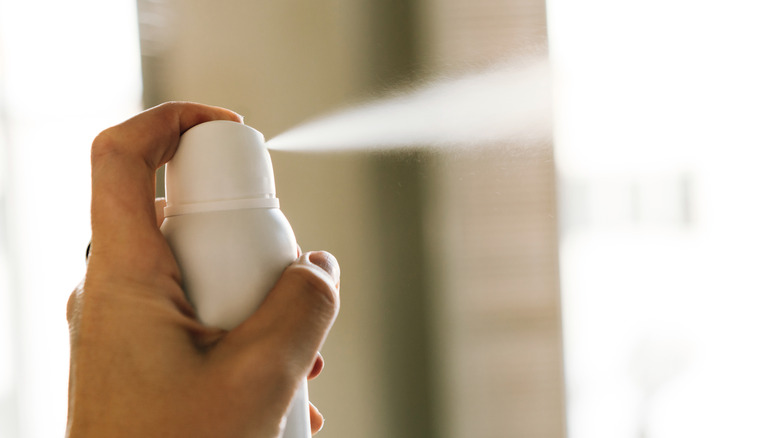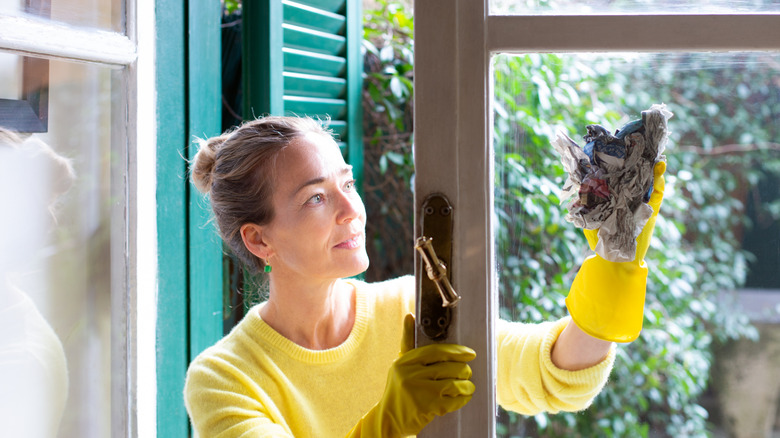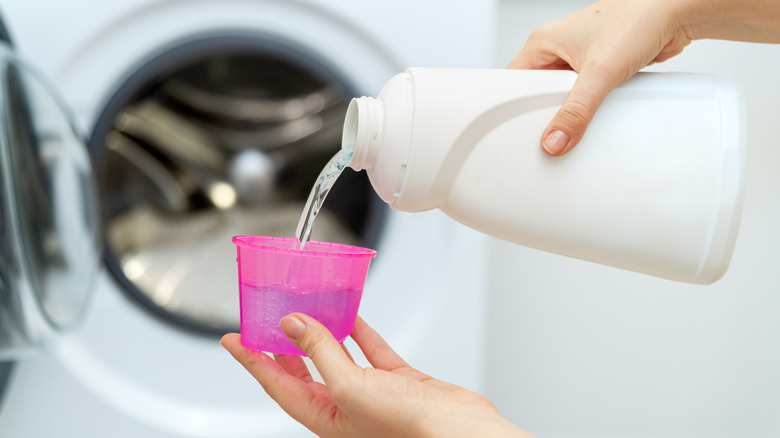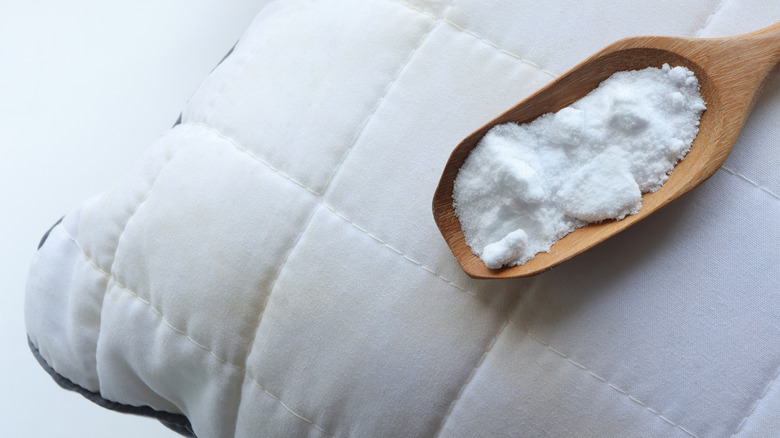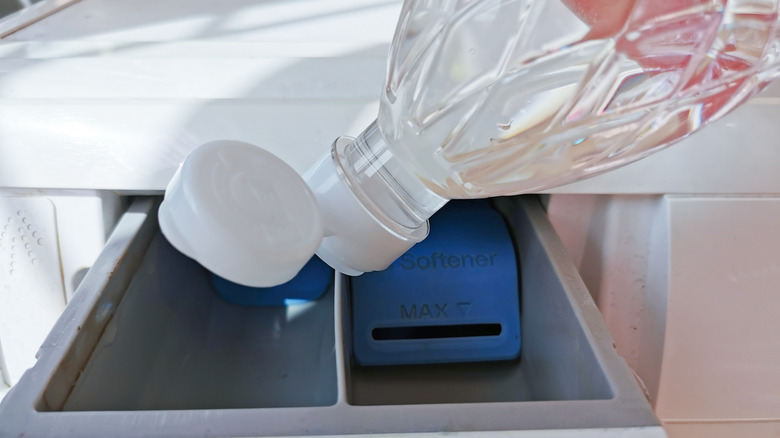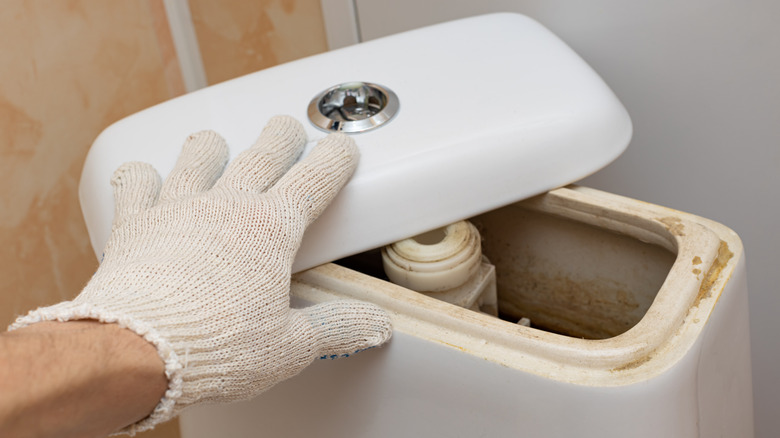10 Decades-Old Cleaning Habits That Are Better Left In The Past, And What To Do Instead
If you're as obsessed with cleaning hacks as we are, you've probably built up a long-term arsenal of your favorite cleaning tips you've learned from the internet — or better yet, had passed down to you from your parents or grandparents. But just because a cleaning hack has been around for a long time doesn't necessarily mean you should be using it. In some cases, the ingredients and materials that once made these cleaning tips so great have changed over time. Or, a cleaning tip you've been following for a long time turns out to be completely wrong and actually harmful.
While there are certainly some favorite vintage cleaning tips that you should totally be using, it's not always a good idea to turn to decades-old cleaning hacks for advice. We've myth-busted a long list of hacks that have been around for decades, but that you definitely shouldn't be using anymore. If you're just as disappointed as we are that you can't use these cleaning tips — like white vinegar in your washing machine — we've made sure to include a few alternatives for each outdated method that will actually work.
Using baking soda and vinegar together
Baking soda and white vinegar are two beloved natural cleaning agents — so it stands to reason that those looking for their next favorite cleaning hack would try mixing them together. In the past, baking soda and vinegar have been recommended together in order to lift stains from hard surfaces and fabrics alike. When you pour white vinegar onto baking soda, it starts to bubble — which means it's working, right?
Unfortunately, vinegar and baking soda bubble because they're actually neutralizing each other. In short, vinegar has a low pH, making it an acidic cleaner, while baking soda has a high pH, making it a basic cleaner. Both of these pHs can individually help break down stains and grime very effectively, but when they're used together, their pHs cancel each other out, so the solution you're left with will be about as effective as plain water.
The best way to ensure baking soda and vinegar are effective is simply to use them separately. White vinegar on its own or diluted with water is great for polishing dinnerware or for cleaning your laminate counters. If you want to turn baking soda into a paste that's easy to spread, try mixing it with water. For extra cleaning power, you can also mix hydrogen peroxide with baking soda, which will make an effective paste that doesn't neutralize itself.
Adding fabric softener to your laundry
Fabric softener is just another one of those extraneous cleaning products that isn't worth buying and using — especially on your clothes. You probably use it because it claims to leave your clothes feeling soft and brand new again. Behind the scenes, however, your fabric softener is actually building up on your clothes with every wash.
Fabric softener isn't made to come off of fabric with just plain soap and water. As you continue to add more fabric softener to your clothes over time, it starts to layer onto your clothes, creating waxy buildup that will eventually make your clothes stiff, not soft. Even worse, fabric softener can create a barrier between the fabric on your clothes and the laundry detergent you use, preventing your clothes from actually being cleaned in the wash. Once your fabric softener has built up on your clothes, it could also cause your skin to be irritated. Using fabric softener regularly can even cause it to build up in your washing machine, which will eventually clog it — not to mention make it more likely to mold.
The best alternative to fabric softener is simply to wash with your normal detergent, and to do so regularly. You can also use dryer balls in your dryer, which are reusable and are typically made of felt or wool — they'll help your clothes and sheets come out soft and wrinkle-free. If you feel that your linens are in desperate need of a softening, you can always try soaking them in vinegar and water to soften them; however, it's recommended to hand wash them afterwards, since vinegar can damage your laundry machine over time (more on that later).
Using toilet cleaners on your grout
There's a popular trend of using toilet bowl cleaner to clean grout in your bathroom. But what's meant for one area of your bathroom isn't necessarily good for another. Toilet bowl cleaner can certainly make your toilet white again, but even if it does the same for your grout, it will also cause your grout break to down over time. In fact, if you use it, you might notice pieces of grout peeling away from your tile, as the toilet bowl cleaner breaks down the sealant. This doesn't just risk damaging your tile, but will also make your grout dirtier in the long run; once your grout is no longer sealed, it's more likely to fall victim to mold.
Instead, seek out a dedicated grout cleaner that can get rid of dirt without damaging the grout. You could also try using an all-purpose cleaner, which will usually be much gentler than a product meant to clean your toilet (which often involves bleach or other sanitizing chemicals). You can also look for a mold removal product that's safe to use on grout, which can help bring your grout back to its regular color. Don't forget to also clean your grout regularly — at least every few showers — to prevent dirt or mold buildup. You can scrub it with just water, or use a little dish soap to remove dirt.
Stripping your laundry regularly
Laundry stripping is a popular trend that involves dumping your clothes into a bathtub full of Borax, water, and detergent. It's intended to remove all the buildup that a regular laundry cycle can't get. It's oh-so-satisfying; you'll probably notice that the bathtub water turns dark — but all that color coming out of your clothes and into your bathtub isn't just dirt and grime. It's actually mostly dye from your clothes and linens. The truth is that most people don't need to strip their laundry, especially not on a regular basis — it's enough to just run it through the washing machine. You can also wash your clothes in the tub with detergent if you'd rather not dump the dirt straight into your laundry machine. If you "need" to strip your laundry, then you're probably washing your clothes incorrectly in the first place.
The process of laundry stripping is typically meant for those who have clothes that are used heavily a daily basis. Work uniforms or farm clothes are both good examples; these types of outfits accumulate more dirt and mud than you want your washing machine to handle. It's also best to use on whites, as then you don't have to worry about the color bleeding. If you do use fabric softener on your linens or clothes and notice that they're starting to get waxy, then laundry stripping is also for you. But don't make it a part of your weekly cleaning routine; for most people, laundry stripping items due to fabric softener should be done twice a year at most. Doing it any more than this will cause your clothes to wear faster over time, and could end up affecting their color.
Using hairspray to remove fabric stains
Have you ever heard of the trick that involves cleaning an ink stain with hairspray? This is a cleaning hack that used to work well, but isn't quite as effective now. When this hack first came around, hairspray contained high levels of alcohol. Spraying it on an ink or Sharpie stain would help to gently lift the stain out, purely because of the alcohol content in the hairspray.
Today, hairspray doesn't usually contain as much alcohol as it once did, and many hairsprays are also alcohol-free. That's not to say that some hairsprays won't still work to remove ink stains; if you know your hairspray brand has a high alcohol content, then you're one of the lucky ones who can continue to rely on this hack. Whether it's worth wasting your hairspray on an ink stain is up to you — there's actually a cheaper solution you can try: rubbing alcohol. Plain ol' rubbing alcohol is by far the best way to go here. It's easy to keep on hand for stain removal in a pinch, and it's much cheaper than most modern hairsprays — whether they use alcohol as an ingredient or not.
Cleaning your windows with newspaper
The trick of cleaning your windows with newspaper has been around for a long time. The original idea was that newspaper was the perfect way to clean your windows without leaving streaks — not to mention the fact that most people were buying newspapers daily and had plenty left on hand, making it cost-effective. In the world of electronic news, however, newspapers are less common — and we also have access to plenty of other budget-friendly materials to clean glass with.
Newspaper won't damage your glass if you do decide to use it, but it can leave a lot of ink stains behind. The paper is also quite thin, which means that it can tear easily when wet, leaving paper fiber behind as well. If you want to clean more than one window, you'll also need to have a lot of newspaper on hand, as it will eventually become too wet and mushy to use the same piece for cleaning.
Today, a microfiber cleaning cloth is a much better option for cleaning your windows without any streaks — and it's reusable. A squeegee is also a good option for a sustainable, streak-free shine. Buy or DIY your own glass cleaner to use on your windows, alongside your reusable rag, and you'll have clean windows that don't involve scrapping the daily paper.
Always using a full cup of laundry detergent
There was once a point where the markers on the cap of your laundry detergent actually told you how much of the soap you should use per load. But, detergents now are becoming more concentrated, so the same amount may not apply. Not only will this make you go through your container of laundry detergent much faster, which isn't great for your budget, but it's also not good for your clothes.
Accidentally going overboard with the detergent every once in a while won't do much to your clothes, but continuously using too much can actually create buildup on your clothes that's similar to the residue left behind by fabric softener. Over time, your clothes will collect dirt and grime because of this buildup, causing their colors to fade and fabrics to wear much faster than they would otherwise. Clothes that have been washed in a surplus of detergent are also much more likely to irritate your skin.
Rather than using an entire capful of laundry detergent, you should use 1 tablespoon of detergent per an 8 pound load of laundry. If you have a larger load of laundry to wash, such as one around 12 pounds, you can use 2 tablespoons of detergent. If you don't want to grab a spoon every time you do the laundry and aren't confident about eyeballing it, make a new mark on the cap of your laundry detergent instead.
Vacuuming up baking soda from your mattress
A sprinkle of baking soda over your bare mattress was originally intended to help freshen up your mattress while you wash your linens. Baking soda soaks up extra moisture in your mattress, helping to prevent mold, and can also act as a scent neutralizer, so your mattress continues to smell fresh. It can be tough to find the perfect way to clean a mattress that can't exactly be washed, so it's disappointing to say that this hack isn't advised for everyone.
In order to remove the baking soda from your mattress, you'll probably be instructed to vacuum up the baking soda after letting it sit. However, doing this can cause some serious damage to your vacuum. Many types of vacuums aren't meant to take up lots of small particles like baking soda, and these can cause your vacuum to jam, potentially damaging its internal parts. The exception would be if your vacuum has a HEPA filter; this type of filter is able to support vacuuming up small particles. Always check your vacuum's specs if you decide to try this hack for yourself.
If your vacuum isn't up to the task, then you can try vacuuming your soda-less bedsheets in between washes to remove dirt. Air out your mattress regularly to prevent moisture, and spritz it with a bit of white vinegar and water to take care of the smell, making sure to let it dry fully before putting sheets back on. Set on using baking soda? Try bringing your mattress outside and shaking it off instead (though, this will be tricky if your mattress is large).
Adding vinegar to laundry loads
You've probably heard that vinegar is great for freshening up your clothes. It can make your fabric softer, your clothes smell better, and it's also fantastic at removing that mildewy smell that comes from leaving your clothes in the dryer for too long. Some also believe that adding vinegar to your washing machine and running a cycle on empty can help to clean it. However, it's not a great idea to use vinegar in your laundry machine at all. Because it's acidic, over time, vinegar can break down various parts of your washing machine.
That doesn't mean that you can't use vinegar on your clothes at all, however; it's a wonderful cleaning agent when it's used outside of your washing machine. Instead of putting it your laundry machine, try soaking clothes in a mixture of vinegar and water to remove odors and give your clothes a clean, fresh smell. This can also help to remove certain stains (such as oil-based ones), and is a good way to deep-clean your clothes from time to time.
Once your clothes are done soaking in vinegar, rinse them thoroughly. After the vinegar has been removed from your clothes, it's time to put them in the washing machine and run a regular cycle with nothing but soap and water. This will give your clothes the cleaning power of vinegar, without damaging your washing machine.
Using bleach in your toilet tank
Seeing mold in your toilet bowl (especially just a little while after you last cleaned it) can be frustrating. Your toilet isn't just a haven for bacteria, but it's also a moist, enclosed environment that's totally perfect for mold to grow. It makes sense that one popular cleaning hack is to add a cup of bleach — mold's number one enemy — into your toilet tank. The idea here is that every time you flush, bleach will be swirled through your toilet bowl, ensuring mold can't grow. Not to mention, this hack is also supposed to take care of the mold that can grow in your toilet tank, too.
As much as we wished this hack worked, bleach is actually pretty bad for the components inside your toilet. Everything from your toilet's flush valve to its gaskets will erode over time when exposed to bleach — even after it's been diluted. This is why cleaning your toilet bowl with bleach is perfectly fine, but exposing the parts in your toilet tank to the chemical isn't a good idea.
Though scrubbing down your toilet bowl regularly is one of everyone's least favorite chores, it's also the way that will most effectively combat mold without having to resort to methods that could damage your toilet. If you're still noticing that your toilet bowl grows mold very quickly, don't forget to check the inside of your toilet tank and give it a good scrubbing. Sometimes, mold can build up inside of your toilet tank without you noticing, contributing to more mold problems on the inside of the bowl.
